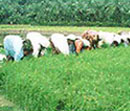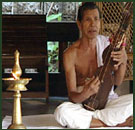Looking into the rich folk tradition of Kerala , one could find a repertoire of timeless folk musicals. The variety ranges from songs that accompany theyyam, the ritual art form to the songs sung in farm-time.
|
 |
The folk songs in Malayalam that reflect an immaculate and earnest glance into the folk life, have been carried over from one generation to next. Owing to this, the songs have undergone changes and variations with respect to time and place.
|
Giving in to them, one could share the ebb of the typical Keralite humdrum.
Both the pleasure and pain of toiling all day form the theme of such songs. Malayalam language does possess a rich repertoire of songs sung by the folks to ease the burden of labor. Songs sung during farm –time, those sung in the occasion of boat race, those sung while going for hunting and lot more. There also exist other varieties like thiruvathira songs, marriage-songs, Onam songs, that were sung to amuse folk gatherings. Besides these, there are also songs related to hero worship and chivalry, songs appraising the concept of beauty, the famous vadakkan and Thekkan Pattu traditions. These songs have contributed immensely to the development of Malayalam poetry and music.
|
| Occupational songs |
| The occupational songs serve as ever living records of the folk life and their imagination. |
 |
In this regard the farm- time songs, deserve special mention owing to their abundance and variety. Also known as Naattu paattukal, such songs
Sublimate the agonies and miseries in their life. |
| |
| songs |
Song2 |
|
|
\pämïpIfmbn XeapdIfneqsS ]IÀón«pÅhbmWv aebmf¯nse
\mS³]m«pIÄ. XeapdIfneqsS ]Icpt¼mÄ Cu ]m«pIÄ¡v Imem\pkrXhpw tZim\pkrXhpamb amä§Ä kw`hn¨n«pïv. Pohsâ kXymßIamb Nn{XoIcWamWv \½psS \mS³ ]m«pIÄ. BßmÀ°hpw efnXhpamb BhnjvIcWssien Cu
]m«pIfpsS {]tXyIXbmWv. tIcfa®nsâbpw tIcfP\PohnX¯nsâbpw X\na Cu
]m«pIfneqsS Adnbm³ km[n¡pw.
|
sXmgnðcwKs¯ kt´mjhpw thZ\bpw sXmgnemfnIfpsS
]m«pIfmbn amdpóp. A[zm\¯nsâ £oWw AdnbmXncn¡m\mbn sXmgnð kab¯v AhÀ ]mSnbncpó [mcmfw ]m«pIfpïv.
|
 |
Irjn¸m«pIÄ, hôn¸m«pIÄ
\mbm«p]m«pIÄ XpS§n At\IXc¯nepÅ sXmgnð]m«pIfpïv. XncphmXnc¸m«pIÄ, HmW¸m«pIÄ XpS§nbhsbms¡ hnt\mZ¯nsâ `mKambn P\§Ä
]mSnbncpóhbmWv. IeymW¸m«pIÄ, Dd¡p]m«pIÄ, hocmcm[\, kuµcymcm[\ XpS§nbhbpambn _Ôs¸«]m«pIÄ, IYmKm\§fmb hS¡³ ]m«pIÄ, sX¡³ ]m«pIÄ Fónhsbñmw tIcf¯nsâ \mtSmSn¸m«pIfpsS k¼óXsbbmWv shfnhm¡póXv. hfsc efnXamb coXnbnemWv Hmtcm]m«pIfptSbpw AhXcWw. Cu Km\§Ä tIcfobkwKoX¯n\pw aebmfIhnXbv¡pw hfsctbsd kw`mh\IÄ sNbvXn«pïv.
|
| sXmgnð]m«pIÄ |
hnhn[ PohnXhr¯nIfnð GÀs¸«ncn¡pó P\hn`mK§fpsS ]m«pIÄ AhcpsS PohnXcoXnbpw `mh\mhnemkhpw H¸w shfns¸Sp¯póhbmWv. F®w sImïpw sshNn{Xyw sImïpw Gähpw IqSpXð {i²bmIÀjn¡póXv Irjn¸m«pIfmWv. kwLw tNÀópÅ Irjn¸Wnbnð AhÀ sh¨p]peÀ¯pó BlvfmZhpw A`nam\hpw {]Imin¸n¡pó C¯cw ]m«pIÄ
Rmäp]m«pIsfópw Adnbs¸Spóp. IÀjIcpsS AhiXIÄ, ZpJ:§Ä, Ahc\p`hn¡pó A\oXnIÄ Fónh hnhcn¡pó [mcmfw
]m«pIfpw \nehnepï v.
|
| |
|